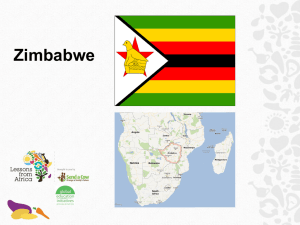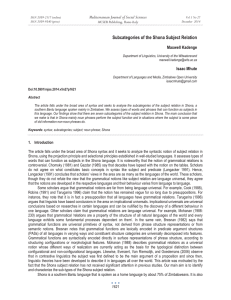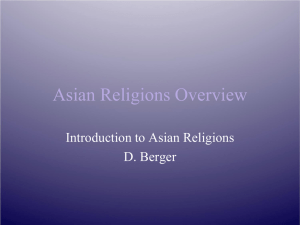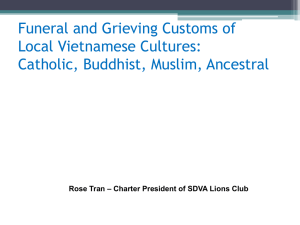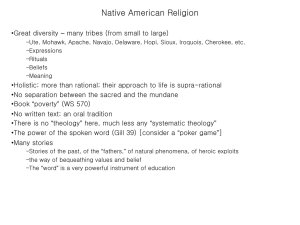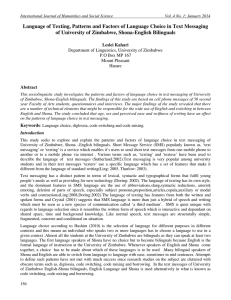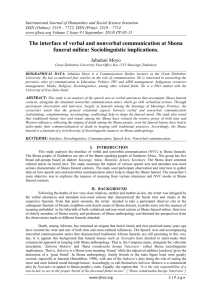African Traditional Religions: Attitudes to Nature
advertisement
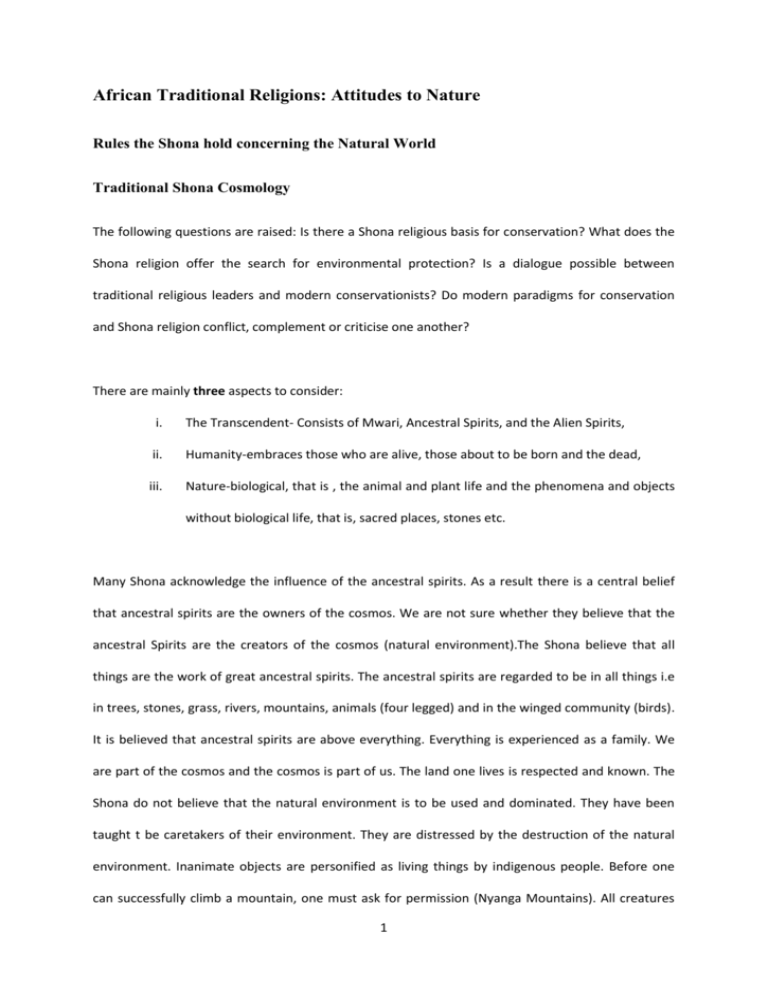
African Traditional Religions: Attitudes to Nature Rules the Shona hold concerning the Natural World Traditional Shona Cosmology The following questions are raised: Is there a Shona religious basis for conservation? What does the Shona religion offer the search for environmental protection? Is a dialogue possible between traditional religious leaders and modern conservationists? Do modern paradigms for conservation and Shona religion conflict, complement or criticise one another? There are mainly three aspects to consider: i. The Transcendent- Consists of Mwari, Ancestral Spirits, and the Alien Spirits, ii. Humanity-embraces those who are alive, those about to be born and the dead, iii. Nature-biological, that is , the animal and plant life and the phenomena and objects without biological life, that is, sacred places, stones etc. Many Shona acknowledge the influence of the ancestral spirits. As a result there is a central belief that ancestral spirits are the owners of the cosmos. We are not sure whether they believe that the ancestral Spirits are the creators of the cosmos (natural environment).The Shona believe that all things are the work of great ancestral spirits. The ancestral spirits are regarded to be in all things i.e in trees, stones, grass, rivers, mountains, animals (four legged) and in the winged community (birds). It is believed that ancestral spirits are above everything. Everything is experienced as a family. We are part of the cosmos and the cosmos is part of us. The land one lives is respected and known. The Shona do not believe that the natural environment is to be used and dominated. They have been taught t be caretakers of their environment. They are distressed by the destruction of the natural environment. Inanimate objects are personified as living things by indigenous people. Before one can successfully climb a mountain, one must ask for permission (Nyanga Mountains). All creatures 1 are perceived as kin. The assumption is that they are endowed with consciousness and the powers of the ancestral spirits. Some animals convey certain messages, for example, snakes, hyena, birds, owl are associated with some mystery (mashura). Traditional people are conscious of the interdependence of all things; that all things depend on each. They therefore have a reciprocal rather than a dominating with all beings. Trees, animals, insects etc are all to be approached with caution and consideration. If one must cut down a tree or kill an animal they must first explain their intentions. There is need to be a justification and ask for forgiveness from the ancestral spirits. The Shona relationship with the environment is a caretaker relationship. In certain places and beings the power of ancestral spirits is believed to be highly concentrated. As a result, there are sacred sites recognised by the power that believer feel there. Certain areas are kept intact because they are regarded as sacred; they remain virgin. When the Shona are forced off their ancestral lands they feel the loss of access to their sacred power sites as a great tragedy. Special stone and animal artefacts may also carry power, for example, leopard or python skin. These are usually put on by n’angas and chiefs. Not everybody goes out to look for a leopard or snake; there is a limited community which has access to these animals. For the Shona there is need for responsibility for both the individual and the community. Land and natural resources are considered a communal property belonging to the living and the dead. Chiefs, sub-chiefs and spirit mediums oversee matters related to land and natural resources’ proper use. It is morally wrong to cut down trees in sacred places. It is also forbidden to gather fruits in grave sites. Reverence towards nature and natural places is a religious attitude and practice. Taboos are developed around the destruction of trees. They are also developed around certain shrubs, sacred places, forests, rivers and wells (metal objects are not allowed at some wells). Some taboos are developed around particular animals, for example, an owl is a bad omen. There is also the idea of 2 totems. Most animals are preserved because they are totemic animals. Religious taboos and restriction take the place of aforestation campaigns undertaken by the government of Zimbabwe in partnership with non-governmental organizations. Animal species were preserved for generations as a result of the systems of religious values and beliefs. Shona religious beliefs seem to teach stewardship and responsibility towards natural resources. However, Shona societies are undergoing great changes due to the impact of the western value systems particularly the western economic system. The money economy has altered social relations among the Shona. It has also affected the Shona people’s attitude to nature and natural resources. Natural resources are now seen as objects for exploitation and profit making. Economic activities which seem to threaten Shona economy are done in the name of development. The introduction of state control over natural resources has destroyed indigenous belief system. The Romantic school tend to celebrate the Shona religious beliefs and values as a rallying point for environmental ethic. There is need for caution since the attitudes of traditional religion to nature is ambivalent. For example, everything connected to totemism is puzzling. Extreme opposites coincide: good and evil, accepted and forbidden practices. Some animal species can be preserved for generations as a result of totemism while others will not. The situation is worse for those species that seem to fall outside the Shona system of religious values and beliefs. This amounts to discriminative attitude to nature. Attitudes to a particular aspect may lead to a privileged access to natural resources. For example, there is a taboo that forbids commoners to eat the flesh of an antbear because it burrows the land. But the antbear is a delicacy for the chief. The chief’s family may protect even some animals of religious significance for consumption only. So the chief and his family may have a privileged access to natural resources. Worse still, totemic animals by virtue of taboos attached to their parts are open to killing. The Shona kill them for special rituals or for using their skins for ceremonial dress for chiefs or when diviners perform rituals for public interest. 3 Regarding the land, the land outside a particular chiefdom may not be sacred to people of another kingdom same applies to water bodies. This means that trees and water bodies are prone to falling victim to exploitation by people who do not attach any sacrality on these things. There is a different understanding of nature in terms of its sacredness. Some aspects are disregarded and treated with the least fear/care and reverence because they are not hierophanic in any sense. Those treated as hierophanies or as ends in themselves suffer the least. This means that Shona attitudes to nature are ambivalent. Extreme attitudes coincide: ecologically responsible and ecologically harmful. 4


